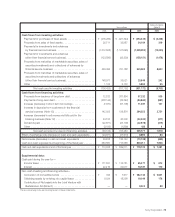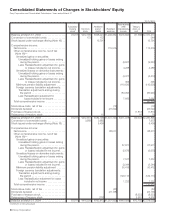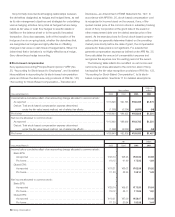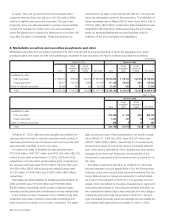Sony 2005 Annual Report Download - page 88
Download and view the complete annual report
Please find page 88 of the 2005 Sony annual report below. You can navigate through the pages in the report by either clicking on the pages listed below, or by using the keyword search tool below to find specific information within the annual report.Sony Corporation 85
■ Employers’ disclosures about pensions and other
postretirement benefits
In December 2003, the Financial Accounting Standards Board
(“FASB”) issued FAS No. 132 (revised 2003), “Employers’ Disclo-
sures about Pensions and Other Postretirement Benefits” (“FAS
No. 132(R)”), which revised FAS No. 132, “Employers’ Disclosures
about Pensions and Other Postretirement Benefits”, an amend-
ment of FAS No. 87, “Employers’ Accounting for Pensions”, FAS
No. 88, “Employers’ Accounting for Settlements and Curtailments
of Defined Benefit Pension Plans and for Termination Benefits”,
and FAS No. 106, “Employers’ Accounting for Postretirement
Benefits Other Than Pensions”. FAS No. 132(R) revised employ-
ers’ disclosures about pension plans and other postretirement
benefit plans. It did not change the measurement or recognition of
those plans required by FAS No. 87, 88 and 106. While retaining
the disclosure requirements of FAS No. 132, FAS No. 132(R)
requires additional disclosures about assets, obligations and cash
flows. The provisions of FAS No. 132(R) were generally effective
for financial statements with fiscal years ending after December
15, 2003, excluding the disclosure of certain information about
foreign plans. The information about foreign plans is effective for
fiscal years ending after June 15, 2004. In accordance with FAS
No. 132(R), (Note 15), Pension and severance plans, has been
expanded to include the new disclosures.
■ Consolidation of variable interest entities
In January 2003, the FASB issued FASB Interpretation (“FIN”)
No. 46, “Consolidation of Variable Interest Entities—an Interpre-
tation of ARB No. 51”. FIN No. 46 addresses consolidation by a
primary beneficiary of a variable interest entity (“VIE”). Sony early
adopted the provisions of FIN No. 46 on July 1, 2003. As a
result of adopting the original FIN No. 46, Sony recognized a
one-time charge with no tax effect of ¥2,117 million as a cumu-
lative effect of accounting change in the consolidated statement
of income, and Sony’s assets and liabilities increased by
¥95,255 million and ¥97,950 million, respectively. These in-
creases were treated as non-cash transactions in the consoli-
dated statement of cash flows. In addition, cash and cash
equivalents increased by ¥1,521 million. See Note 23 for further
discussion on the VIEs that are used by Sony.
In December 2003, the FASB issued revised FIN No. 46 (“FIN
No. 46R”), which replaced FIN No. 46. Sony early adopted the
provisions of FIN No. 46R upon its issuance. The adoption of
FIN No. 46R did not have an impact on Sony’s results of opera-
tions and financial position or impact the way Sony had previ-
ously accounted for VIEs.
(2) Significant accounting policies:
■ Basis of consolidation and accounting for investments in
affiliated companies
The consolidated financial statements include the accounts of
Sony Corporation and its majority-owned subsidiary companies,
general partnerships in which Sony has a controlling interest,
and variable interest entities for which Sony is the primary
beneficiary. All intercompany transactions and accounts are
eliminated. Investments in business entities in which Sony does
not have control, but has the ability to exercise significant influ-
ence over operating and financial policies generally through 20-
50% ownership, are accounted for under the equity method. In
addition, investments in general partnerships in which Sony
does not have a controlling interest and limited partnerships are
also accounted for under the equity method. Under the equity
method, investments are stated at cost plus/minus Sony’s
equity in undistributed earnings or losses. Consolidated net
income includes Sony’s equity in current earnings or losses of
such companies, after elimination of unrealized intercompany
profits. If the value of an investment has declined and is judged
to be other than temporary, the investment is written down to its
fair value.
On occasion, a consolidated subsidiary or an affiliated com-
pany accounted for by the equity method may issue its shares
to third parties in either a public or private offering or upon
conversion of convertible debt to common stock at amounts per
share in excess of or less than Sony’s average per share carry-
ing value. With respect to such transactions, where the sale of
such shares is not part of a broader corporate reorganization
and the reacquisition of such shares is not contemplated at the
time of issuance, the resulting gains or losses arising from the
change in interest are recorded in income for the year the
change in interest transaction occurs. If the sale of such shares
is part of a broader corporate reorganization, the reacquisition of
such shares is contemplated at the time of issuance or realiza-
tion of such gain is not reasonably assured (i.e., the entity is
newly formed, non-operating, a research and development or
start-up/development stage entity, or where the entity’s ability to
continue in existence is in question), the transaction is ac-
counted for as a capital transaction.
The excess of the cost over the underlying net equity of
investments in consolidated subsidiaries and affiliated compa-
nies accounted for on an equity basis is allocated to identifiable
assets and liabilities based on fair values at the date of acquisi-
tion. The unassigned residual value of the excess of the cost
over the underlying net equity is recognized as goodwill.
■ Use of estimates
The preparation of the consolidated financial statements in
conformity with U.S. GAAP requires management to make
estimates and assumptions that affect the reported amounts of
assets and liabilities and disclosure of contingent assets and
liabilities at the date of the financial statements and the reported
amounts of revenues and expenses during the reporting period.
Actual results could differ from those estimates.
BH6/30 Adobe PageMaker 6.0J /PPC
























